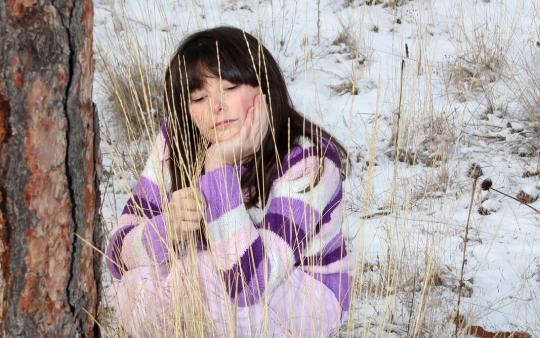Sixteen-year-old Subashini Thangadurai thinks a lot about the future of the planet; like many kids, she’s concerned. “Worrying about the climate crisis has always seemed like a shadow that followed me for as long as I can remember. Perhaps it's because the enormity of the climate crisis was so overwhelming and alarming,” says Thangadurai, a Calgary-based youth climate activist.
Millions of children and teens around the world are already dealing with the impacts of climate change, and millions more are hearing about it every day at school, on the news, from friends and family—everywhere.
According to Professor Mala Rao, Senior Clinical Fellow at the Department of Primary Care and Public Health, Imperial College, London, the climate crisis is causing an increase in psychological distress in youth around the world. Rao is also Chair of a group of experts on the environmental determinants of climate change and health at the WHO South East Asia Region, and a long-standing campaigner for climate action.
ECO-ANXIETY IS GROWING
The American Psychological Association first defined eco-anxiety in 2017 as “a chronic fear of environmental doom.” While climate anxiety is not a formally diagnosable disorder, Rao says the condition and its psychological impacts on an individual’s beliefs and behaviours are becoming increasingly well recognized. When people hear about the climate crisis, flooding, and year-round forest fires, climate anxiety can occur, the term describes a full range of emotions such as worry, distress, and guilt.
In 2021 researchers from the UK, Finland and the US published the first large-scale global survey of climate anxiety in children and young people aged 16 to 25. The survey found that 84 percent were at least moderately worried about climate change, and 59 percent were very or extremely worried. The emotions that they described ranged from sad and anxious, to angry and powerless. Around half of those surveyed highlighted that their daily lives and functioning were affected by climate anxiety.1,2 This study reinforced the conclusions of a survey published in 2020 by the UK Royal College of Psychiatrists, which revealed that over half (57 percent) of child and adolescent psychiatrists surveyed in England, were seeing children and young people distressed about the climate crisis and the state of the environment.3
“This is not surprising because climate change is the biggest threat humanity is facing.” —Mala Rao, PhD
REACHING OUT AND TAKING ACTION
Subashini Thangadurai has dealt with climate change worries and found it difficult at times. Over time, she learned to manage the emotions that came with these worries, and figure out what strategies worked best for her. It's important to talk about your worries with someone you trust; Thangadurai credits her family, teachers, and other youth for helping her overcome her worries about the climate crisis. Environmental activism has also helped her and other kids too. As a member of Alberta Youth Leaders for Environmental Education (AYLEE), Thangadurai co-authored a white paper calling for more climate education and hands-on climate action to be integrated into all school curricula.
“It's important to talk about your worries with someone you trust; Thangadurai credits her family, teachers, and other youth for helping her overcome her worries about the climate crisis.”
5 TIPS TO SUPPORT YOUR CHILD
Parents may also feel fearful about the future. The most effective way to alleviate their own and their children’s worries is to explore how families can act together to have a positive impact on climate change. It’s important to be self-aware about your own fears for the future before you can help your child. Strive to adopt a positive, compassionate, and supportive environment for your child, to help them manage any climate worries.
1. Listen to their fears with empathy; acknowledge their points of view and reassure them that their concerns are valid and deserve to be addressed.
2. Support their environmental interests and help them make any changes to their lifestyles that they suggest. For example, make a game out of turning off lights more often, choose to make more plant-based meals, and bike to school with your kids instead of driving. If they want to join an environmental club at school, help them do that; if their school lacks hands-on environmental education opportunities, tap into the expertise of climate education organizations. You can also request outdoor classrooms and more environmental education opportunities at your child’s school.
3. Get outdoors in nature as a family. Model healthy coping behaviours for your children by participating in soothing activities like going for a walk together in a forest, which has the dual benefit of improving emotional and physical well-being. Planting a tree or gardening with your child can be a fun option. Not only are kids spending more time outdoors, which is healing, but planting trees and gardening teaches them important skills and makes them part of the solution. And kids want to help.
4. Create change by encouraging your kids to channel their emotions into poetry, music, dance, journalling, painting, and other creative projects. Highlight their gifts and post their projects around the house to show them that you value their work.
5. Take action by helping them join environmental education programs at school, summer camp, or in your community. You can even organize a fun beach or neighbourhood clean-up party. There may be climate action organizations in your community offering volunteer opportunities to show them that they have a voice and can make important contributions to the climate movement too.
If your child’s anxiety begins to interfere with their ability to function, it’s important that you seek guidance from a healthcare professional.
For references visit ecoparent.ca/WIN22






